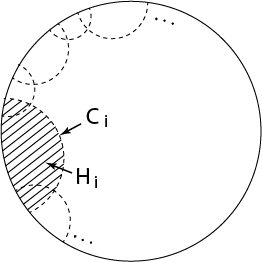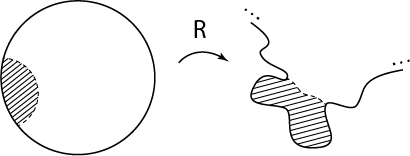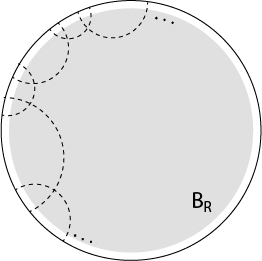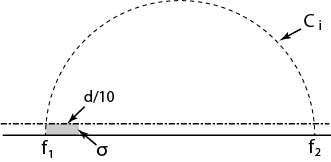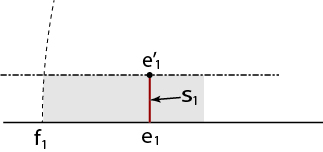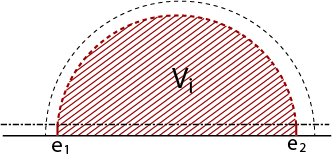To commemorate passing the French exam earlier this week (without knowing any French) and also to test this program ‘latex to wordpress‘, I decided to post my French-translation assignment here.
Last year, I went to Paris and heard a French talk by Crovisier. Strangely enough, although I can’t understand a single word he says, just by looking at the slides and pictures, I liked the talk. That’s why when being asked the question ‘so are there any French papers you wanted to look at?’, I immediately came up with this one which the talk was based on.
Here is a translation of selected parts (selected according to my interest) in section 1.2 taken from the paper `Récurrence et Généricité‘ ( Inventiones Mathematicae 158 (2004), 33-104 ) by C. Bonatti and S. Crovisier. In which they proved a connecting lemma for pseudo-orbits.
Interestingly, just in this short section they referred to two results I have discussed in earlier posts of this blog: Conley’s fundamental theorem of dynamical systems and the closing lemma. In any case, I think it’s a cool piece of work to look at! Enjoy~ (Unfortunately, if one wants to see the rest of the paper, one has to read French >.<)
Precise statements of results
1. Statement of the connecting lemma for pseudo-orbits
In all the following work we consider compact manifold equipped with an arbitrary Riemannian metric and sometimes also with a volume form
(unrelated to the metric). We write
for the set of diffeomorphisms of class
on
with the
topology and
the subset preserving volume form
.
Recall that, in any complete metric space, a set is said to be residual if it contains a countable intersection of open and dense sets. A property is said to be generic if it is satisfied on a residual set. By slight abuse of language, we use the term generic diffeomorphisms: the phase ‘generic diffeomorphisms satisfy property ‘ means that property
is generic.
Let be a diffeomorphism of
. For all
, an
-pseudo-orbit of
is a sequence (finite or infinite) of points
such that for all
,
. We define the following binary relations for pairs of points
on
:
– For all , we write
if there exists an
-pseudo-orbit
where
and
for some
.
– We write if
for all
. We sometimes write
to specify the dynamical system in consideration.
– We write (or
) if for all neighborhoods
of
and
, respectively, there exists
such that
intersects
.
Here are a few elementary properties of these relations.
1. The relations and
are, by construction, transitive. The chain recurrent set
is the set of points
in
such that
.
2. The relation is not a-priori transitive. The non-wandering set
is the set of points
in
such that
.
Marie-Claude Arnaud has shown in [Ar] that the relation is transitive for generic diffeomorphisms. By using similar methods we show:
Theorem 1: There exists a residual set in
(or in
) such that for all diffeomorphisms
in
and all pair of points
in
we have:
This theorem is a consequence of the following general perturbation result:
Theorem 2: Let be a diffeomorphism on compact manifold
, satisfying one of the following two hypotheses:
1. all periodic orbits of are hyperbolic,
2. is a compact surface and all periodic orbits are either hyperbolic or elliptic with irrational rotation number (its derivative has complex eigenvalues, all of modulus
, but are not powers of roots of unity).
Let be a
-neighborhood of
in
(or in
, if
preserves volume form
). Then for all pairs of points
in
such that
, there exists a diffeomorphism
in
and an integer
such that
.
Remark: In Theorem 2 above, if the diffeomorphism if of class
with
, then the
-perturbation
can also be chosen in class
. Indeed the diffeomorphism
is obtained thanks to a finite number of
-perturbations given by the connecting lemma (Theorem 2.1), each of these perturbations is itself of class
.
Here are a few consequences of these results:
Corollary: There exists a residual set in
such that for all diffeomorphism
in
, the chain recurrent set
coincides with the non-wandering set
.
Corollary: Suppose is connected, then there exists a residual set
in
such that if
satisfies
then it is transitive. Furthermore,
is the unique homoclinic class for
.
For volume preserving diffeomorphism , the set
always coincide with the whole manifold
. We therefore find the analogue of this corollary in the conservative case (see section 1.2.4).
2. Dynamical decomposition of generic diffeomorphisms into elementary pieces
Consider the symmetrized relation of
defined by
if
and
. This relation then induces an equivalence relation on
, where the equivalence classes are called chain recurrence classes.
We say a compact -invariant set
is weakly transitive if for all
, we have
. A set
is maximally weakly transitive if it is maximal under the partial order
among the collection of weakly transitive sets.
Since the closure of increasing union of weakly transitive sets is weakly transitive, Zorn’s lemma implies any weakly transitive set is contained in a maximally weakly transitive set. In the case where the relation is transitive (which is a generic property), the maximally weakly transitive sets are the equivalence classes of the symmetrized relation induced by
on the set
. Hence we obtain, for generic diffeomorphisms:
Corollary: There exists residual set in
such that for all
the chain recurrence classesare exactly the maximally weakly transitive sets of
.
The result of Conley (see posts on fundamental theorem of dynamical systems) on the decomposition of into chain recurrence classes will therefore apply (for generic diffeomorphisms) to the decomposition of
into maximally weakly transitive sets.
3. Chain recurrence classes and periodic orbits
Recall that after the establishment of closing lemma by C. Pugh (see the closing lemma post), it is known that periodic points are dense in for generic diffeomorphisms, we would like to use these periodic orbits to better understand the dynamics of chain recurrence classes.
Recall the homoclinic class of a hyperbolic periodic point
is the closure of all transversal crossing points of its stable and unstable manifolds. This set is by construction transitive, as we have seen in section 1.2, the results of [CMP] imply that, for generic diffeomorphisms any homoclinic class is maximally weakly transitive. By applying corollary 1.4, we see that:
Remark: For generic diffeomorphisms homoclinic classes are also chain recurrence classes.
However, for generic diffeomorphisms, there are chain recurrence classes which are not homoclinic classes, therefore contains no periodic orbit, we call such chain recurrence class with no periodic points aperiodic class.
Corollary: There exists residual set in
such that for all
, any connected component with empty interior of
is periodic and its orbit is a homoclinic class.
The closing lemma of Pugh and Remark 5 show:
Remark: For generic , any isolated chain recurrence class in
is a homoclinic class. In particular this applies to classes that are topological attractors or repellers.
For non-isolated classes, a recent work (see [Cr]) specifies how a chain recurrence class is approximated by periodic orbits:
Theorem: There exists residual set in
such that for all
, all maximally weakly transitive sets of
are Hausdorff limits of sequences of periodic orbits.
More general chain recurrence classes satisfy the upper semi-continuity property: if is a sequence of points converging to a point
then for large enough
, the class of
is contained in an arbitrary small neighborhood of the class of
.




